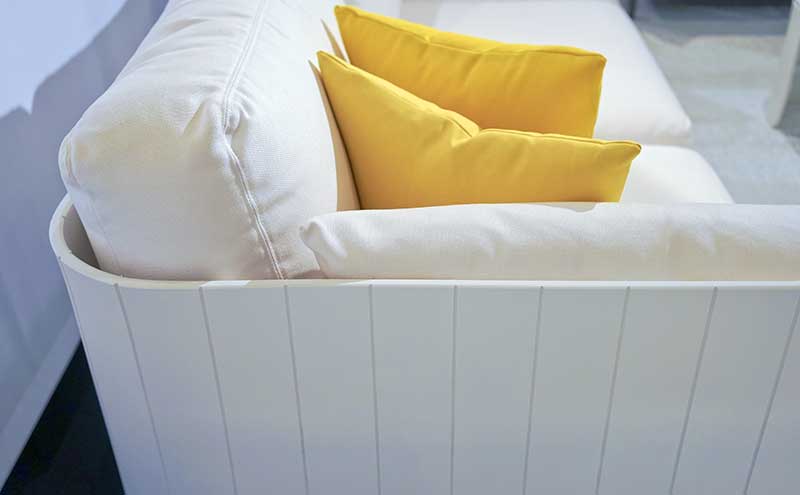The 2015 International Contemporary Furniture Fair (ICFF) was more than twice the size of last year’s design extravaganza, with over 700 exhibitors displaying their products. But certain themes emerged from the seemingly endless sea of styles. One was the infatuation of many of this year’s participating designers with bold bright colors. There also was a celebration of the multicultural with modern interpretations of Arabic, Central American and Persian textiles. In the midst of all of the exuberant eclecticism, some designers took a more restrained route with compelling displays of minimalist modern wood chairs and tables made from dark woods.
This year marked the debut of ICFF’s partnership with Fiera Milano under the label HO.MI., which showcased a sizeable contingent of Italian trendsetters from the recent Salone del Mobile in Milan. Overall, this year’s ICFF was about getting groovy with a wave to California. The biggest hits for design mavens gravitated towards items that ventured on the wild side such as tables made from reclaimed wood, psychedelic 3-D wallpaper and indoor-outdoor couches crafted from recycled milk jugs.
The biggest splash this year was made by Art Center College of Design (Pasadena, California) student Hui Ling Cheng, whose spare but refined walnut Tui chair was both an ICFF Studio Finalist and also a winner of the prestigious ICFF award for Best Seating. The Tui chair is not yet commercially produced, but given its reception at ICFF, you can be sure that it soon will be available in a store near you.
Another show-stopper was DEEP 3-D wallpaper, a line of trippy three-dimensional wallpaper that comes in five different patterns ranging from a display of sinuous cellular shapes to one showing Viking ships being tossed about on the seas. Developed by a partnership between Pratt Institute and the eco-friendly company twenty2, this wallpaper is intense even when you are not wearing 3-D glasses and is printed with “Earth-friendly water-based inks”.
London-based textile designer Anne Kyyrö’s handmade acoustic 3-D wall coverings brought organic beauty to a field traditionally dominated by industrial design. Inspired by the natural world, the brown sheet of leather peapod shapes on display at ICFF is effective at controlling frequencies exceeding 1 kilohertz.
Some of the most popular exhibits resolved perennial design challenges. The Sunnyside Collection is a series of modular upholstered furniture that succeeds in bringing indoor comfort outdoors. This breakthrough, which picked up the ICFF Editors Award for Best Outdoor Seating is the product of a collaboration between product designer Brad Ascalon, interior designer Ghislaine Viñas and the Minnesota-based LOLL Design. All about feeling good, the Sunnyside Collection comes in cheerful colors and it is made from recycled milk jugs.
- Sunnyside Collection. Courtesy of LOLL Design.
- Sunnyside Collection. Courtesy of LOLL Design.
- Sunnyside Collection. Courtesy of LOLL Design.
Among the most beautifully crafted pieces was a bold reinterpretation of that classic male piece of male furniture, the pool table, by the Belgian company Fusiontables, which happens to be one of the world’s leading manufacturers of billiard balls. The model of its Fusion Table on display at ICFF had a removable white lacquered top intended for dining that slides away to reveal a pink pool table underneath. According to Fusion Table’s website, the Fusion Table is intended to be a piece of furniture that a “pool player’s wife could live with.”
The hand-woven rugs made in India and designed by the Brooklyn, New York-based boutique AELFIE were a notable example of the heterogeneous influences at work in the design world today. AELFIE’s rugs were distinguished by bold colors and geometric designs that managed to look both tribal and modern. Not only do these wool-cotton blend dhurries promise to liven up a space but they are also tough and made for active use.
Liberated from the aesthetic strictures of past designers, the new generation seems to have crossed all kinds of frontiers when it comes to patterns, colors and materials. Hui Ling Cheng’s Tui chair, for example, represented an updated and refreshing take on minimalism, a style that all too often has been used to austere effect in the past. The most important trend this year is the growing number of designers concerned with cradle-to-grave manufacturing and producing products that haven’t been made in a sweatshop.















